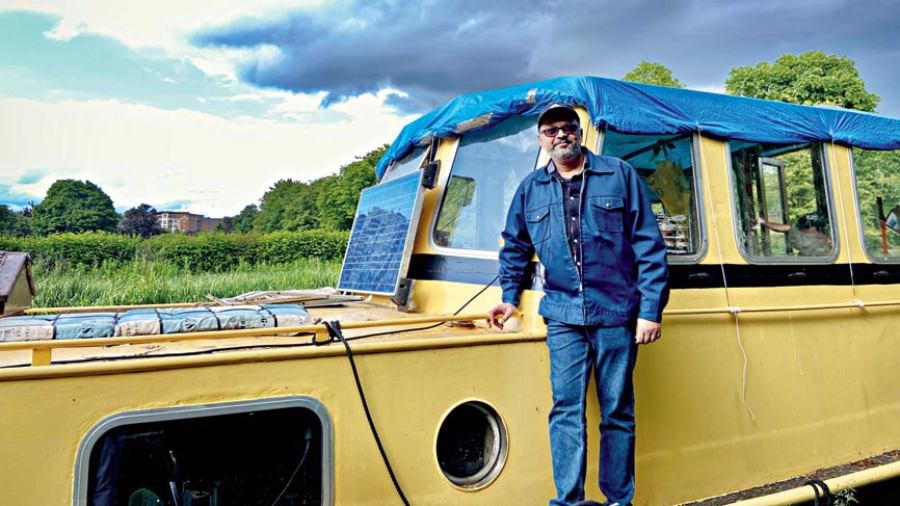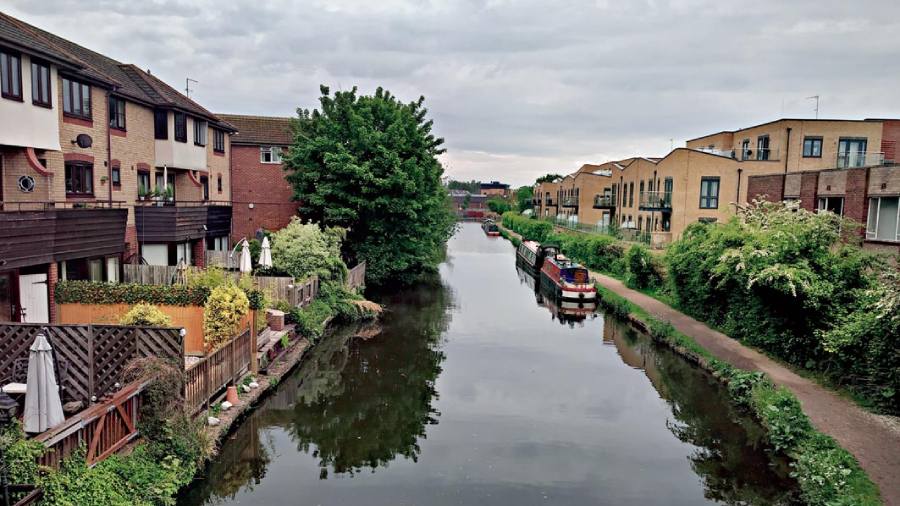And when the brokenhearted peopleLiving in the world agreeThere will be an answerLet it beFor though they may be partedThere is still a chance that they will seeThere will be an answerLet it be
It is noon. After a long run of overcast and rainy days in London, the sun is shining bright. A short bearded street musician in his mid-60s is singing the well-known Beatles’ number, Let It Be. Sitting at Dickens Yard, close to Ealing Town Hall, he is a one-man-band, playing on the acoustic guitar and harmonica mounted over the microphone, his left foot tapping on a percussion drum set.
A district of West London, Ealing is a historic county of Middlesex. It is often referred to as Ealing Broadway, which is the name of both a railway station and a bustling shopping centre. Although the connection of Dickens Yard with the celebrated author might seem tenuous, one of Charles Dickens’ sons gave a reading of his father’s novel David Copperfield at Ealing in May 1889. Nevertheless, in more recent times, the name of Dickens resurfaced in Ealing with the development of the town centre by Walter John Dickens, one of the leading builders in the area.
Despite the amazing music he is creating — from John Denver to Mick Jagger — the street singer isn’t getting much attention from passers-by. Maybe the sight of street musicians is too common in most metropolises. So, only occasionally, someone will stop by, listen, or drop a penny or a pound into the open guitar case that is lying in front of him. Each donation is acknowledged with a warm “Thank you” from the musician.
Following four or five numbers, the man stands up to take a break and straighten his muscles, which are used extensively to play multiple instruments. Right there, a young girl steps forward with a cardboard box of cakes and cookies and hands it over to him. With an exchange of familiar smiles, I follow the girl to discover she is actually running the makeshift cake shop next to where he is performing.

Kaushik and Atanu
A student of fine arts and painting, Sophie is from Holland. Her classes begin at 4pm. To support herself, she rises early, cooks up the bakeries, and sets up a tent shop in the same spot three days a week. Occasionally, this man appears out of nowhere and sings right next to her shop. “He’s from Syria. He came here years back to be a professional musician, but he couldn’t. For a time, he played at the Soho Theatre. A true bohemian, he often disappears for months together,” Sophie said, as she pulled down her canvas tent with folding poles to pack them into a small suitcase, which she will carry to her class. “Anything left unsold, I give to him,” she said, her pretty face beaming with warmth and empathy.
Curiously, this small episode rings a bell with the story I chose to film in London — Aaro Ek Prithibi, Yet Another World — a tale of people who are on the run throughout their lives, desperately seeking a place to settle down, and longing to live peacefully and securely. But in this rootless age, the concept of home has become tarnished and elusive. It follows the journey of Pratiksha, (played by Tasnia Farin), a young girl who desperately seeks shelter that has eluded her since she was 11.
As we began scouting for locations, we encountered an assortment of immigrant car drivers — a strikingly handsome Afghani man Ali, who is quite disillusioned with the city of London and longs to return to his native place after accumulating a fortune; a Pakistani woman chauffeur Shabnam, who recounts in meticulous detail how she fled and traversed illegally to many other cities carrying her three children in tow after separating from her husband; or the ever-smiling young Arab Arif, who showed his YouTube channel where he sang songs vehemently protesting against the Arab-Israel conflict that has caused millions of people to suffer in Palestine.
While talking to them, I remembered Mrs Hughes from Downtown Abbey saying, “There’s no shame in feeling homesick. It means you come from a happy home.”
In our film, Srikanta Munshi (played by Kaushik Ganguly) left his home in Calcutta 15 years back presumably to explore the world with his own eyes. He endured many trials and tribulations before settling down in London, living not on land, but on a houseboat! So the first crucial location for us was to find a boat with adequate interiors where we could shoot for two days. Our location manager led us to Hertfordshire inside Southern London to discover the idyllic countryside with an old pub named The Three Horseshoes, featuring rustic furnishings and a large old-fashioned lounge area.
A 137-mile stretch of the Grand Union Canal runs from London to Birmingham right in front. It passes through some of the most picturesque towns and villages. The scene became even more mesmerizing as the sky grew dark and cloudy. We were waiting for Barry, whose boat we had planned to shoot, to return.
The canal network of the United Kingdom played an invaluable role during the Industrial Revolution. Nearly 4,500 miles of canals were constructed during this period. Raw materials could be transported more quickly and cheaply by canals than by land.
At present, approximately 4,000 boats ply through London’s rivers and canals, with no fewer than 10,000 people living on them. Known as “continuous cruisers”, these boats move from one mooring spot to another every fortnight. Many of these spots have community ties, with their children attending school, and they have access to general physicians and other health services. Most people who live on boats enjoy the lifestyle. Also, this can also be a cheaper solution than brick-and-mortar. It’s a second golden age for the canals of London as the number of boats has nearly doubled in the last decade.
Barry turned out to be yet another fascinating character. “Not my home, this grand old city, but it’s my ultimate refuge. I love rowing through these canals. They are more beautiful than all the places people throng to see here,” he says. The wildly energetic and tough 57-year-old has been living on boats for the past nine years, having repaired the latest one extensively after purchasing it in Holland.
His boat, Star Oars, transports logs from a boatyard far away! He has a video on YouTube showing how he converted an abandoned vessel into one that regularly traverses long distances on the Grand Union Canal running on a Perkins diesel engine! Although captivated by the charm of Barry’s personality, we were unable to utilise his boat since it was quite small. Our search for an ideal ‘home’ for Srikanta continued.
Whether we were strolling through Oxford Street, the busiest shopping street in the West End, or walking through Camden, a haven for counter culture, we often encountered homelessness of varying types on the sidewalks. One evening, on our way back from Soho, we spotted a young man shivering helplessly near Trafalgar Square, clinging desperately to a rather flimsy blanket; or an old woman sitting on the doorstep near Harrods, her eyes staring at nothing.
Each time I saw one of them, I remembered the book I read as a reference before writing the script for my film. Titled Four Feet Under: Untold stories of homelessness in London, it is probably one of the most difficult texts I’ve ever read. Not an enjoyable read by any means, it’s harrowing, scary, and disturbing. As I turned each page, I found myself grateful for the small things we take for granted: a roof over our heads, a place to stay safe at night, the provision for having something to eat, and the love of our family. Through the course of this shooting, we came across some of the unfortunate people who, through tragedy, misfortune, and bad decisions, have been left homeless, dispossessed and destitute on the streets of London. The surge in homelessness predicted in the pandemic is now a reality.

Atanu on Mark's boat
For Mark, however, residing on a boat is a choice. Illustrator of books and posters of independent films, he lives alone on a boat with his dog, Tom. And the vessel has a plush interior, with two bedrooms, an open kitchen, a workspace, library, toilet, and even a film viewing room! “Living on a boat has all kinds of benefits — cheap rent, stunning views, inspiration for philosophy and creativity; it may make you more attractive at parties, but results aren’t guaranteed,” he laughed boisterously. Mark’s workspace has framed pictures of his wife and children. When I inquired about how often they visit, he quickly replied, “Not very often”.
Mark’s boat, then moored at Hemel Hempstead, provided the most suitable shelter for our Srikanta, allowing us to shoot smoothly inside its spacious interiors.
The entire day, we were envious of Mark’s adventurous lifestyle as well as excited about the breathtaking views the windows offered when it moved through different places. But when we packed up around midnight, it was an entirely different scene. The canal was pitch dark and there was an eerie silence all around.
“Do you ever feel alone during this time?” I asked Mark again. “Yes, I do,” he responded, as frank as ever — “But Sir, I always remember that the sun will rise again within a few hours!”
The laughter that pervaded the silence of the night echoed with the indomitable spirit of an eternal wanderer!
